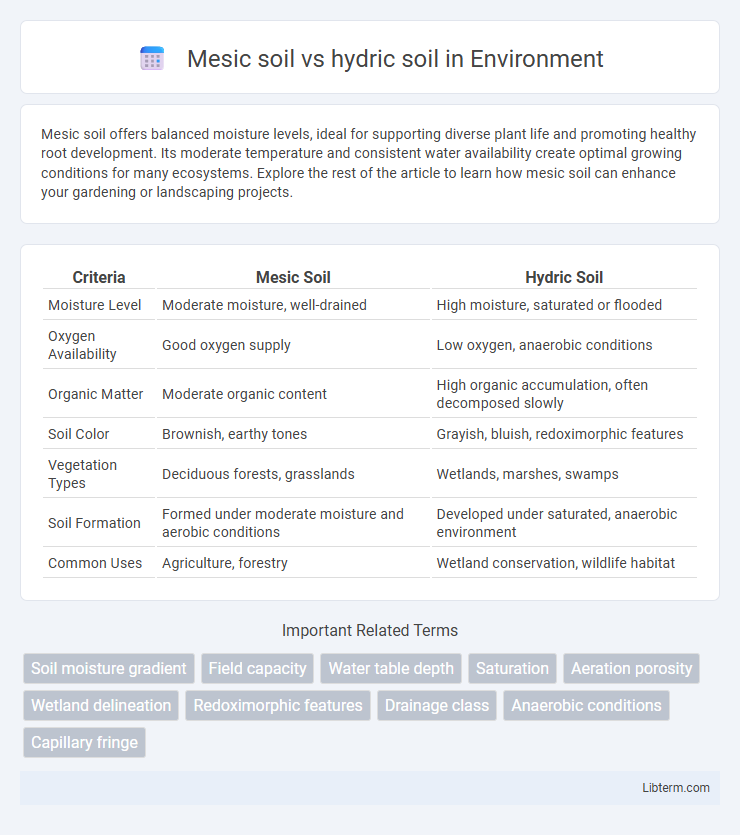Mesic soil offers balanced moisture levels, ideal for supporting diverse plant life and promoting healthy root development. Its moderate temperature and consistent water availability create optimal growing conditions for many ecosystems. Explore the rest of the article to learn how mesic soil can enhance your gardening or landscaping projects.
Table of Comparison
| Criteria | Mesic Soil | Hydric Soil |
|---|---|---|
| Moisture Level | Moderate moisture, well-drained | High moisture, saturated or flooded |
| Oxygen Availability | Good oxygen supply | Low oxygen, anaerobic conditions |
| Organic Matter | Moderate organic content | High organic accumulation, often decomposed slowly |
| Soil Color | Brownish, earthy tones | Grayish, bluish, redoximorphic features |
| Vegetation Types | Deciduous forests, grasslands | Wetlands, marshes, swamps |
| Soil Formation | Formed under moderate moisture and aerobic conditions | Developed under saturated, anaerobic environment |
| Common Uses | Agriculture, forestry | Wetland conservation, wildlife habitat |
Definition of Mesic Soil
Mesic soil refers to soil with a moderate moisture level, neither too dry nor too saturated, supporting a balanced ecosystem with diverse plant species. It contrasts with hydric soil, which is permanently or seasonally saturated with water, often leading to anaerobic conditions crucial for wetland habitats. Understanding mesic soil helps in managing environments that require optimal moisture for agricultural productivity and ecological stability.
Definition of Hydric Soil
Hydric soil is defined by its prolonged saturation, flooding, or ponding conditions that create anaerobic environments essential for wetland ecosystems. Unlike mesic soil, which maintains moderate moisture levels without saturation, hydric soil supports the growth of water-tolerant vegetation and plays a critical role in water filtration and habitat sustainability. Its unique characteristics include organic matter accumulation, reduced iron and manganese, and soil morphology indicative of periodic or permanent saturation.
Key Characteristics of Mesic Soils
Mesic soils maintain moderate moisture levels without prolonged saturation, supporting a wide variety of vegetation adapted to well-drained conditions. These soils exhibit balanced aeration and nutrient availability, with drainage rates that prevent waterlogging but retain sufficient moisture for plant growth. Unlike hydric soils, mesic soils do not develop anaerobic conditions, making them ideal for temperate forests and grasslands.
Key Characteristics of Hydric Soils
Hydric soils are characterized by prolonged saturation or flooding during the growing season, which creates anaerobic conditions essential for wetland ecosystems. These soils typically exhibit features such as gleying, organic-rich layers, and redoximorphic concentrations due to reduced iron and manganese. In contrast, mesic soils maintain moderate moisture without prolonged saturation and support upland vegetation rather than hydrophytic plants.
Formation Processes of Mesic and Hydric Soils
Mesic soils form under moderate moisture conditions where water drainage is sufficient to prevent saturation, allowing aerobic decomposition and well-developed soil horizons. Hydric soils develop in wet environments, such as wetlands or floodplains, characterized by prolonged saturation that leads to anaerobic conditions, reduced oxygen levels, and the accumulation of organic matter. These contrasting formation processes influence soil chemistry, microbial activity, and nutrient cycling, with hydric soils often exhibiting features like gleying and redoximorphic concentrations due to fluctuating water tables.
Water Content Differences: Mesic vs Hydric
Mesic soils maintain moderate water content, supporting well-drained environments without prolonged saturation, which influences plant root oxygen availability and microbial activity. Hydric soils, characterized by high water content due to frequent saturation or flooding, create anaerobic conditions that impact soil chemistry and favor specialized vegetation adapted to wet conditions. The water retention capacity and drainage rate distinctly separate mesic soils from hydric soils, affecting nutrient cycling and soil ecosystem dynamics.
Plant Communities in Mesic and Hydric Soils
Plant communities in mesic soils typically consist of species adapted to moderate moisture levels, such as oak-hickory forests and mixed hardwoods thriving under well-drained conditions. Hydric soils support wetland vegetation, including hydrophytic plants like cattails, sedges, and willows that tolerate or require saturated, anaerobic environments. The distinct moisture regimes influence species composition, biodiversity, and ecosystem functions within mesic versus hydric soil plant communities.
Ecological Importance of Mesic and Hydric Soils
Mesic soils maintain balanced moisture levels supporting diverse plant communities and critical habitats for numerous terrestrial species, contributing to ecosystem stability and biodiversity. Hydric soils, characterized by prolonged saturation, play a vital role in wetland ecosystems by facilitating nutrient cycling, water purification, and flood mitigation. Both soil types underpin ecological functions by sustaining distinctive biological communities and regulating hydrological processes essential for environmental resilience.
Identification and Classification Methods
Mesic soil is identified based on moderate moisture levels, typically determined through field observations and soil moisture retention tests, while hydric soil classification requires indicators of saturation, such as the presence of redoximorphic features and saturation duration. Soil scientists use standardized methods like the U.S. Army Corps of Engineers Wetland Delineation Manual to classify hydric soils by analyzing soil color, texture, and organic content under anaerobic conditions. Mesic soil classification often involves assessment of moisture regimes and soil temperature regimes, utilizing soil surveys and laboratory analysis to distinguish from hydric conditions.
Land Use and Management Considerations
Mesic soils, characterized by moderate moisture content, support diverse agricultural practices requiring balanced irrigation and drainage to prevent water stress or root diseases. Hydric soils, saturated or inundated long enough to develop anaerobic conditions, demand specialized management like wetland conservation, controlled flooding, or adapted crop selections such as rice or cranberries. Land use planning must incorporate soil moisture regimes to optimize productivity and maintain ecosystem services, ensuring hydric soils are protected from drainage or compaction that could alter their ecological function.
Mesic soil Infographic

 libterm.com
libterm.com